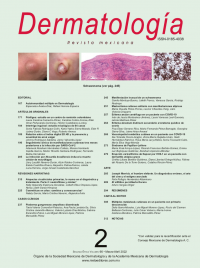Papillon-Lefèvre syndrome.
Dermatol Rev Mex. 2022; 66 (2): 273-278. https://doi.org/10.24245/dermatolrevmex.v66i2.7633
María Xosé Arroyo-López,1 Ricardo Francisco Beltrán-Gómez,2 Emma Luz Bojórquez-Gutiérrez,3 Abraham Apolonio-Méndez4
1 Médico residente de segundo año de la especialidad de Medicina Interna.
2 Médico interno de pregrado.
3 Dermatóloga.
4 Cirujano general.
Hospital General de Zona núm. 2, IMSS, Hermosillo, Sonora, México.
Resumen
ANTECEDENTES: El síndrome de Papillon-Lefèvre es una genodermatosis autosómica recesiva causada por la mutación en el gen que codifica la proteasa lisosomal catepsina C. Se han reportado más de 300 casos en la bibliografía mundial. Se caracteriza por hiperqueratosis palmoplantar, periodontitis y pérdida prematura de los dientes deciduos y permanentes. El tratamiento del síndrome de Papillon-Lefèvre es sintomático y con frecuencia inefectivo.
CASO CLÍNICO: Paciente femenina de 37 años de edad, con consanguinidad parental como único antecedente relevante. Inició su padecimiento a los pocos meses de nacida al manifestar queratodermia palmoplantar y quistes dentales; se diagnosticó con síndrome de Papillon-Lefèvre por un dermatólogo y fue confirmado posteriormente a los tres años de edad por estudios genéticos. Tuvo pérdida prematura de su dentición temporal a los siete años y ausencia de dentición permanente a los 12 años, por lo que comenzó a utilizar prótesis dental desde entonces.
CONCLUSIONES: Los pacientes con síndrome de Papillon-Lefèvre requieren atención multidisciplinaria que incluye dermatólogos, odontólogos y psicólogos, como manejo integral de la afección cutánea y periodontal, de las infecciones frecuentes y de los problemas de depresión que pueden surgir, para ayudar a mejorar la calidad de vida de los pacientes.
PALABRAS CLAVE: Enfermedad periodontal; periodontitis; prótesis dental.
Abstract
BACKGROUND: Papillon-Lefèvre syndrome is an autosomal recessive genodermatosis caused by the mutation in the gene that codifies the lysosomal protease cathepsin C. More than 300 cases in the world literature have been reported. It is characterized by palmo-plantar hyperkeratosis, periodontitis, and premature loss of the deciduous and permanent teeth. Treatment of Papillon-Lefèvre syndrome is symptomatic and often ineffective.
CLINICAL CASE: A 39-year-old female patient, as the only relevant history was parental consanguinity. She began her illness at few months old, when presenting palmoplantar keratoderma and dental cysts; she was diagnosed with Papillon-Lefèvre syndrome by a dermatologist, and it was confirmed subsequently with genetic tests at three years old. She had premature loss of the deciduous teeth at seven years old and absence of permanent teeth at twelve years old, so she began to use dental prosthesis since then.
CONCLUSIONS: Patients with Papillon-Lefèvre syndrome require multidisciplinary care including dermatologists, dentists and psychologists; with comprehensive management of both skin and periodontal disease, frequent infections and depression problems that may arise, all aimed to improve the quality of life of the patients.
KEYWORDS: Periodontal disease; Periodontitis; Dental prosthesis.
Recibido: mayo 2021
Aceptado: mayo 2021
Este artículo debe citarse como: Arroyo-López MX, Beltrán-Gómez RF, Bojórquez-Gutiérrez EL, Apolonio- Méndez A. Síndrome de Papillon-Lefèvre. Dermatol Rev Mex 2022; 66 (2): 273-278.

